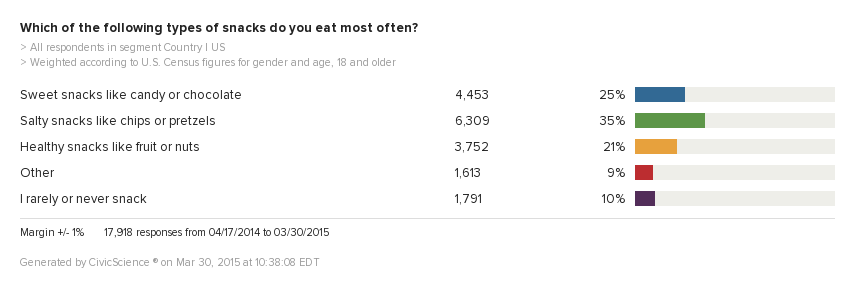Profiling the Various “Snackers”
Consumers are definitely snacking more, and the way people are snacking is evolving. Yes, people still like to munch on their potato chips and chocolate bars, however, healthy snacks are also gaining market share. Consumers are not only snacking in addition to their main meals, but in some cases in place of meals, making it tricky to distinguish the line between snacking and meals. From what we found, you can learn a lot about consumers based on what types of snacks they eat most and when they usually consume their snacks.
In the past year, our online polls asked over 17,000 U.S. adults about their snacking behaviors and when they most like to snack. We found that:
- Only 10% of U.S. adults say they rarely or never snack.
- The majority enjoy snacking the most between lunch and dinner or in the evening after dinner.
- Although most consumers are still noshing on sweet or salty snacks, about 21% are making an effort to choose healthier options (see chart below).

We uncovered some interesting data by profiling the different types of “snackers” – sweet, salty, and healthy, and found that what you snack on can tell a lot about who you are and your behaviors.
Demographics

Those who prefer sweet snacks are more likely to be younger women who do not have children and are more likely to live in the Midwest, while those who prefer healthy snacks are likely to be older, well-educated parents or grandparents who own their own home in the West and have a higher household income. Not only are they buying snacks for themselves, but are probably also buying for their children. Salty snackers seem to fall somewhere in the middle of the other two segments and are more likely to live in the suburbs and Northeast.
Media Consumption & Technology Usage

Those who prefer sweet snacks are more likely to be on social media and say they are influenced by social media when compared to the other segments. Based on past research, women tend to spend more time on social media than men, so this could explain the over-indexing of social media usage among sweet snackers. Sweet and salty snackers are more likely to say they are addicted to their digital devices. Again, when it comes to media consumption and technology usage, the behaviors of those who prefer salty snacks fall in the middle of sweet and healthy snackers. Healthy snackers will be a tough nut to crack for food and beverage companies, because this consumer segment is a little more difficult to reach. They don’t spend as much time on social media and don’t watch as much TV each day as those who prefer sweet or salty snacks.
Health & Lifestyle

When it comes to the health and lifestyle habits of the three segments of consumers, the healthy snackers talk the talk and walk the walk. They are more likely to say they eat healthy, exercise, follow new fitness trends, buy organic and non-GMO food and enjoy to cook. Along these attributes, it seems that the salty snackers and sweet snackers have similar health and wellness lifestyles. The sweet snackers are slightly more likely than the salty snackers to exercise and purchase organic, non-GMO foods; however, they are more likely to eat at fast food restaurants at least once a week. On the other hand, those who prefer salty snacks are slightly more likely to follow fitness news / trends and enjoy cooking.
When Do They Snack?
- Evening is the preferred time for sweet and salty snackers – after dinner or late at night.
- Healthy snackers are more likely than average to say they snack most between meals – either between breakfast and lunch or between lunch and dinner.
Many food and beverage brands offer a variety of snacks, including more healthy options. As we can see here, the type of snack consumers eat most can say a lot about who they are, how they can be reached, their behaviors, and lifestyle choices. By using tailored research data, food and beverage companies can quickly evaluate who they should be targeting and what message would be most appealing to consumers.
During the next few months, we’ll be publishing more detailed research about the snacking trend, with the goal of delivering some appetizing insights that have not been surfaced yet from other market research sources. Sign up below to get our blog round-ups so you don’t miss it!








